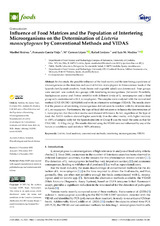Influence of Food Matrices and the Population of Interfering Microorganisms on the Determination of Listeria monocytogenes by Conventional Methods and VIDAS
Autor
Estévez, Maribel
García-Viejo, Fernando
López, Mª Carmen
Jordano-Salinas, R.
Medina Canalejo, Luis M.
Editor
MDPIFecha
2021Materia
ListeriaFood matrices
Conventional methods
Interfering microorganisms
VIDAS
METS:
Mostrar el registro METSPREMIS:
Mostrar el registro PREMISMetadatos
Mostrar el registro completo del ítemResumen
In this study, the possible influence of the food matrix and the interfering population of microorganisms on the detection and count of Listeria monocytogenes in three common foods of the Spanish diet (Spanish omelette, fresh cheese and vegetable salad) was determined. Four groups were assayed: one control, two groups with interfering microorganisms (Salmonella Enteritidis, Staphylococcus aureus and Proteus mirabilis) with different levels of L. monocytogenes and a final group only contaminated with L. monocytogenes. The samples were analyzed with the normalized method (UNE-EN ISO 11290:2018) and with an alternative technique (VIDAS). The results show that the presence of interfering microorganisms did not seem to interfere with the determination of L. monocytogenes. Furthermore, the type of food did not seem to influence the determination of L. monocytogenes, but the culture media used showed differences. In fact, regardless of the type of food, the ALOA medium showed higher sensitivity than the other media, with higher recovery in 100% of samples (only for the Spanish omelette in Group B was the result the same as that for PALCAM, −8.11 log cfu/g). The results obtained using the VIDAS were not influenced by any of the factors or conditions used and show 100% efficiency.

